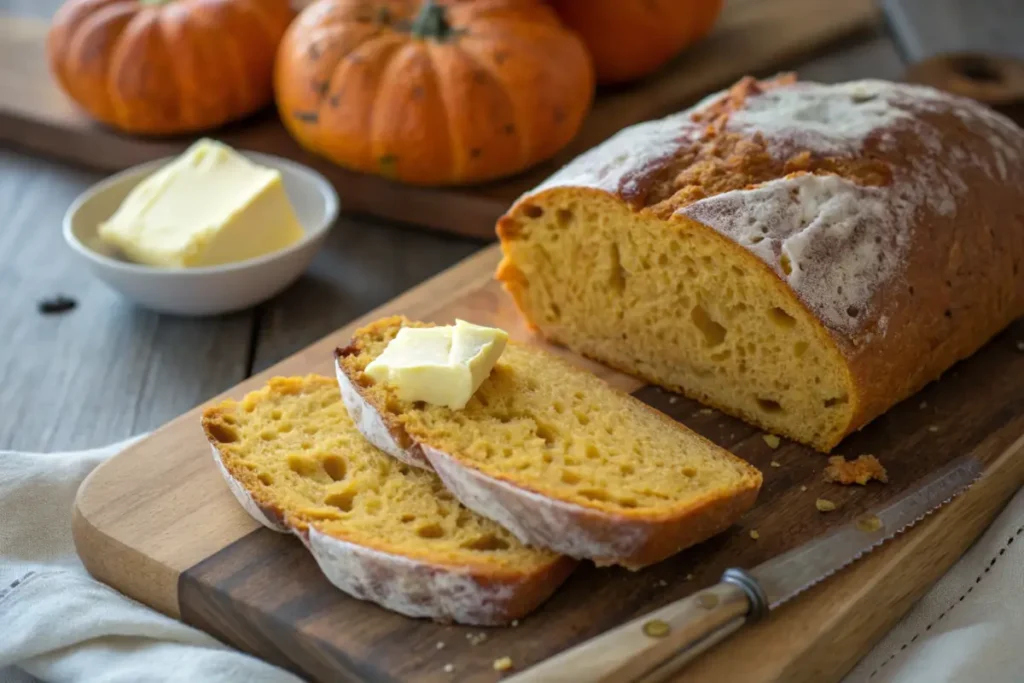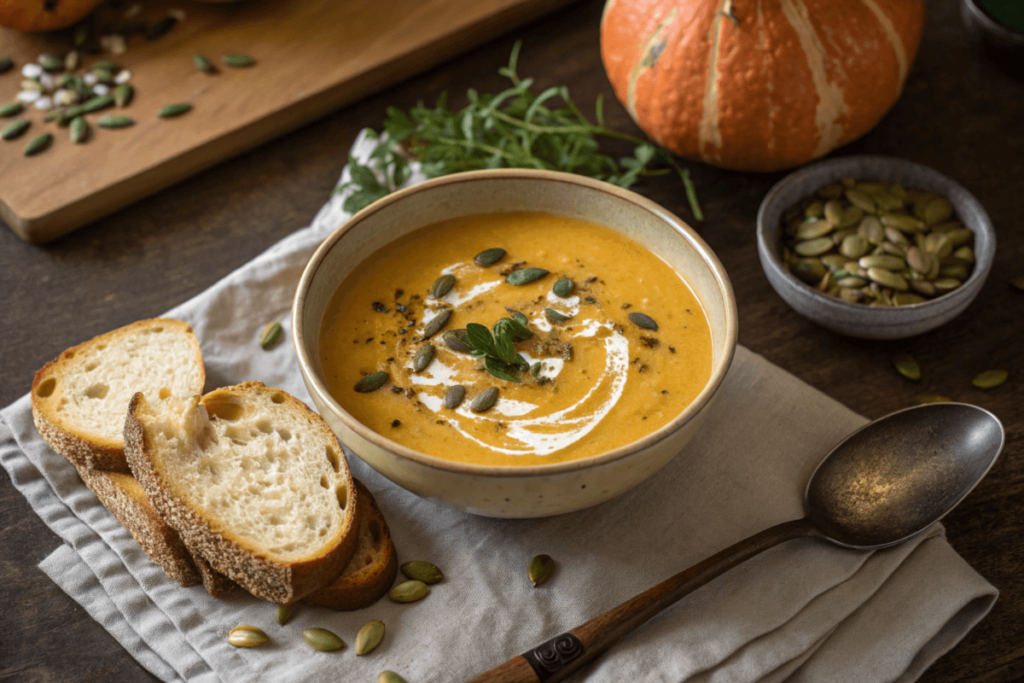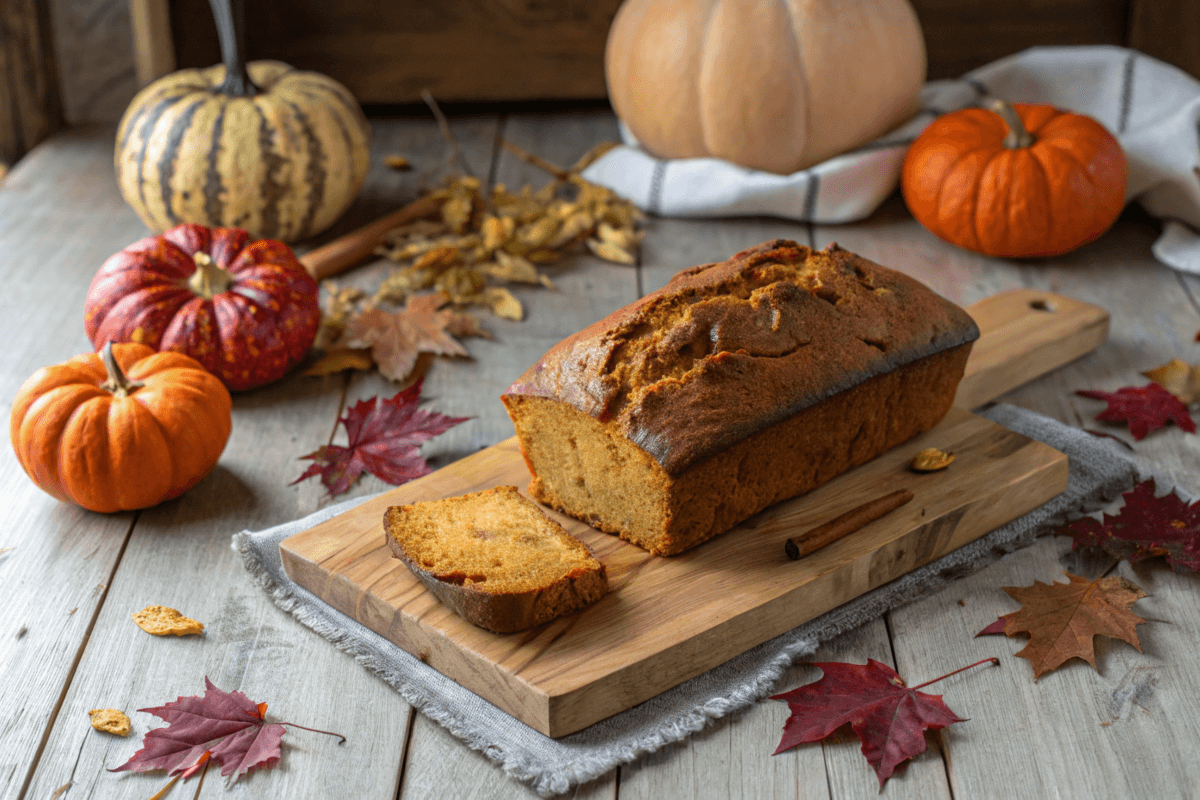Pumpkin sourdough is a delightful variation of traditional sourdough bread that perfectly blends the earthy flavor of pumpkin with the tangy notes of sourdough fermentation. As autumn rolls around, this seasonal favorite captures the hearts of bakers and bread lovers alike. In this article, we’ll dive deep into the nuances of pumpkin sourdough—from its unique flavor profile and texture to how you can make it at home. Whether you’re a seasoned baker or a curious foodie, this guide will inspire you to try (or bake!) this delicious bread.
Let’s start with an introduction to what makes pumpkin sourdough so special!
An Introduction to Pumpkin Sourdough Bread
What is Pumpkin Sourdough Bread?
Pumpkin sourdough bread is a seasonal twist on classic sourdough, incorporating pumpkin puree or roasted pumpkin into the dough. This addition not only enriches the bread’s flavor but also enhances its texture and appearance. Unlike sweet pumpkin bread, which is often a quick bread, pumpkin sourdough maintains the signature tanginess of sourdough while adding a hint of natural sweetness and earthiness from the pumpkin.
The pumpkin, typically blended into the dough, gives the bread a subtle orange hue, making it as visually appealing as it is delicious. It’s a true fusion of autumnal flavors and artisan baking techniques.
Why Pumpkin Sourdough is Popular in Autumn?
Pumpkin sourdough thrives in the fall, when pumpkins are at their peak and cravings for warm, comforting foods abound. This bread evokes a sense of coziness, with its soft crumb and slightly spiced aroma filling kitchens across the globe.
The nutritional benefits of pumpkin also make this bread a popular choice. Pumpkin is rich in vitamins A and C, fiber, and antioxidants, making it a healthier addition to traditional bread recipes. Paired with sourdough’s gut-friendly probiotics, it’s a bread that’s both tasty and nourishing.
Flavor Profile of Pumpkin Sourdough

Tasting Notes: Sweetness and Tanginess
Pumpkin sourdough offers a harmonious mix of flavors that’s both comforting and unique. The natural sweetness of pumpkin perfectly balances the signature tanginess of sourdough, creating a flavor profile that’s neither too sweet nor overwhelmingly sour. With every bite, you’ll notice subtle earthy undertones, a quality brought out by the roasted pumpkin puree often used in the dough.
Interestingly, the fermentation process enhances the pumpkin’s natural sugars, adding a mild caramelized note. This makes pumpkin sourdough an excellent choice for both sweet and savory pairings. Have you ever wondered, What does pumpkin sourdough taste like? It’s like autumn wrapped in a loaf—cozy, hearty, and slightly spiced.
How Pumpkin Enhances Sourdough’s Complexity
The addition of pumpkin doesn’t just add sweetness—it enriches the bread’s overall complexity. Pumpkin contains natural enzymes and fibers that interact with the sourdough starter, slightly altering the fermentation process. This results in a bread that’s lighter, moister, and more nuanced in taste.
Spices like cinnamon, nutmeg, or cloves often accompany pumpkin in the dough, creating a warm, aromatic profile. These spices don’t overpower but instead complement the bread’s natural flavors, making each bite a layered sensory experience. Some bakers even experiment with a sprinkle of pumpkin seeds for an extra nutty crunch.
Texture and Appearance
What Does the Crust Look and Feel Like?
Visually, pumpkin sourdough is a showstopper. The dough’s inclusion of pumpkin gives the crust a deep golden-orange hue, making it stand out among regular loaves. The crust itself is typically crisp and crackly, a hallmark of well-baked sourdough. When you slice into it, the satisfying crunch reveals a soft, airy interior that’s irresistibly inviting.
Pumpkin adds a slightly glossy finish to the crust, a result of its natural sugars caramelizing during baking. The exterior feels rustic but refined—a loaf you’d proudly serve at any gathering.
Interior Characteristics: Softness and Moisture
Inside, the crumb is light, moist, and perfectly tender. Unlike traditional sourdough, which can sometimes lean toward a drier texture, pumpkin sourdough benefits from the added moisture of the pumpkin puree. This gives it an almost cloud-like softness, making it ideal for slathering with butter or spreading with cream cheese.
The hydration levels are higher than regular sourdough, thanks to the pumpkin, which naturally holds water. The result? A bread that stays fresh longer without losing its texture. Have you ever tried pairing pumpkin sourdough with a hot bowl of soup? Its melt-in-your-mouth softness makes it the perfect companion.
Internal Linking Opportunity: For a complementary recipe idea, you might enjoy trying the Pumpkin Banana Loaf from Tester Recipes. It’s another creative way to incorporate pumpkin into your baked goods.
Next up, we’ll explore how to bake pumpkin sourdough at home with step-by-step instructions. Stay tuned!
How to Make Pumpkin Sourdough at Home
Step-by-Step Recipe
Making pumpkin sourdough at home is easier than it sounds, especially if you already have a sourdough starter on hand. Here’s a straightforward recipe to help you get started.
- Gather Your Ingredients:
- 3 cups of bread flour
- 1 cup of pumpkin puree (fresh or canned)
- ½ cup of active sourdough starter
- ½ cup of water
- 1 teaspoon of salt
- Optional: 1 teaspoon of cinnamon or nutmeg for a spiced touch.
- Mix the Dough: Combine the flour, sourdough starter, and pumpkin puree in a large mixing bowl. Gradually add water, mixing until a sticky dough forms. Add salt and mix well.
- Bulk Fermentation: Cover the dough with a damp cloth and let it rest at room temperature for 6–8 hours. During this time, perform 2–3 rounds of stretch-and-folds to build structure.
- Shape the Dough: Lightly flour your work surface and shape the dough into a round loaf. Place it into a floured banneton or bowl, seam side up.
- Proof the Dough: Cover and let it proof in the refrigerator for 8–12 hours. This slow fermentation enhances flavor and texture.
- Bake the Loaf: Preheat your oven to 475°F (245°C) with a Dutch oven inside. Carefully transfer the dough to the Dutch oven, score the top, and bake for 20 minutes covered, then another 15–20 minutes uncovered for a golden crust.
Common Mistakes and How to Avoid Them
- Overproofing: Too much fermentation can result in a flat loaf. Keep an eye on the dough during the bulk fermentation stage.
- Sticky Dough Issues: Pumpkin can make the dough stickier than usual. Don’t hesitate to flour your hands and work surface generously.
- Dense Loaf: This could happen if your sourdough starter isn’t active enough. Make sure your starter is bubbly and well-fed before use.
If you’re curious about how different recipes compare, consider exploring this Pumpkin Banana Loaf for another creative spin on pumpkin-based baking.
Culinary Uses and Pairings

Best Ways to Enjoy Pumpkin Sourdough
Pumpkin sourdough is as versatile as it is flavorful. Its mild sweetness and tangy undertones pair beautifully with a range of foods. For a savory twist, serve it alongside hearty soups or stews—pumpkin sourdough dipped in creamy butternut squash soup is a match made in heaven. For breakfast, it’s divine with a smear of butter, a drizzle of honey, or even your favorite nut butter.
If you’re looking to entertain, pumpkin sourdough makes a stunning centerpiece for a charcuterie board. Its golden hue and slightly sweet flavor balance out salty meats, sharp cheeses, and tangy pickles. It’s the kind of bread that elevates every meal.
How to Store and Maintain Freshness
Pumpkin sourdough stays fresh longer than traditional sourdough, thanks to the moisture in the pumpkin. To keep it at its best:
- Store it in a bread box or wrap it loosely in a clean kitchen towel for up to three days.
- For longer storage, slice the bread and freeze it in an airtight bag. Simply pop slices into the toaster for a quick refresh.
Want more inspiration for your next baking adventure? Browse through Tester Recipes for a variety of creative ideas.
Stay tuned for Part 6, where we’ll tackle frequently asked questions about pumpkin sourdough and address some of the most common curiosities, including What does pumpkin sourdough taste like?
FAQs About Pumpkin Sourdough
What Makes Pumpkin Sourdough Different from Regular Sourdough?
Pumpkin sourdough stands out because of its unique flavor and texture. The addition of pumpkin gives the bread a mild sweetness and earthy undertones that aren’t present in regular sourdough. Furthermore, the natural moisture from pumpkin creates a softer crumb, making the bread feel lighter and fluffier. If you’ve ever wondered, What does pumpkin sourdough taste like?—imagine a perfect blend of tangy sourdough with a touch of autumnal sweetness.
Does Pumpkin Affect the Rising Process?
Yes, pumpkin can impact how the dough rises. The moisture and fiber in pumpkin puree slightly alter the dough’s structure, making it softer and sometimes stickier. However, these differences are minor and can be managed with proper kneading and shaping techniques. Also, pumpkin doesn’t interfere with the fermentation process, so your loaf will still achieve the beautiful rise sourdough is known for.
How Do I Know When Pumpkin Sourdough is Properly Baked?
A well-baked pumpkin sourdough should have a golden-orange crust with a hollow sound when tapped on the bottom. Inside, the crumb should be soft and airy, with no dense or gummy patches. Keep an eye on the crust during baking—it may brown quicker due to the natural sugars in the pumpkin.
Can You Freeze Pumpkin Sourdough?
Absolutely! Pumpkin sourdough freezes well and maintains its flavor and texture when reheated. Slice the loaf before freezing to make thawing easier and quicker.
Final Thoughts and Recommendations
Pumpkin sourdough is more than just a seasonal treat—it’s a versatile and flavorful bread that brings warmth and comfort to any table. From its sweet and tangy taste to its moist, fluffy texture, this bread is a delight for both seasoned bakers and curious foodies. If you’re wondering, What does pumpkin sourdough taste like?, the answer is simple: it tastes like autumn in every bite.
Whether you enjoy it plain, toasted with butter, or paired with your favorite soups and spreads, pumpkin sourdough adapts beautifully to any meal. Baking it at home might seem intimidating, but with the right recipe and some patience, you’ll find it’s easier than you think—and the rewards are delicious.
For those who love experimenting in the kitchen, consider adding pumpkin sourdough to your baking repertoire. Its rich flavor and eye-catching appearance make it a crowd-pleaser for gatherings or a cozy addition to your weekday meals.
If this article inspired you, why not try baking your first loaf? Or, for more ideas, check out other creative recipes on Tester Recipes. Happy baking!
Health Benefits of Pumpkin Sourdough
Nutritional Value of Pumpkin Sourdough
Pumpkin sourdough combines the health benefits of both pumpkin and sourdough bread into a single, flavorful package. Pumpkins are packed with essential nutrients, including vitamins A and C, potassium, and antioxidants. These nutrients support eye health, boost immunity, and contribute to glowing skin. Meanwhile, sourdough’s fermentation process makes it easier to digest and more nutrient-dense than conventional bread.
Incorporating pumpkin into sourdough adds fiber, which helps regulate digestion and keeps you feeling full longer. Plus, the natural sweetness of pumpkin reduces the need for added sugars, making it a healthier choice. So if you’ve ever asked yourself, What does pumpkin sourdough taste like?, it’s worth noting that it tastes as wholesome as it is delicious.
Why Pumpkin Sourdough is Gut-Friendly
The fermentation process involved in sourdough baking creates probiotics, which promote a healthy gut. When paired with the fiber from pumpkin, this bread supports better digestion and contributes to overall gut health. The lower glycemic index of sourdough, compared to regular bread, also makes it a good option for those watching their blood sugar levels.
Pumpkin sourdough isn’t just a treat for your taste buds—it’s a bread that nourishes your body. Whether you enjoy it for breakfast or as a midday snack, it’s a smart and tasty addition to your diet.
Tips for Serving and Customizing Pumpkin Sourdough
Creative Ways to Serve Pumpkin Sourdough
Pumpkin sourdough is incredibly versatile, making it a great addition to your meals in many ways. For a comforting breakfast, try toasting it and topping it with cream cheese and a sprinkle of cinnamon. It’s also perfect as the base for avocado toast, especially when paired with a dash of chili flakes for a spicy kick.
For lunch or dinner, pumpkin sourdough shines when used to make hearty sandwiches. Pair it with turkey, cranberry sauce, and arugula for a seasonal twist. Its slightly sweet flavor complements savory dishes like stews, soups, or even roasted vegetables.
And don’t forget dessert! Pumpkin sourdough can be transformed into a decadent bread pudding or French toast that’s sure to impress.
Customizing Pumpkin Sourdough to Suit Your Tastes
One of the joys of baking is experimenting with flavors, and pumpkin sourdough is no exception. For a spiced loaf, try adding cinnamon, nutmeg, or cloves to the dough. You can also fold in raisins, dried cranberries, or chopped nuts to enhance its texture and taste.
If you’re feeling adventurous, consider sprinkling the crust with seeds like pumpkin or sunflower for added crunch. This not only elevates the flavor but also makes the loaf even more visually appealing.
Whether you keep it simple or go bold with customizations, pumpkin sourdough offers endless possibilities. Now, next time someone asks, What does pumpkin sourdough taste like?, you’ll have plenty of ideas to share and enjoy!

